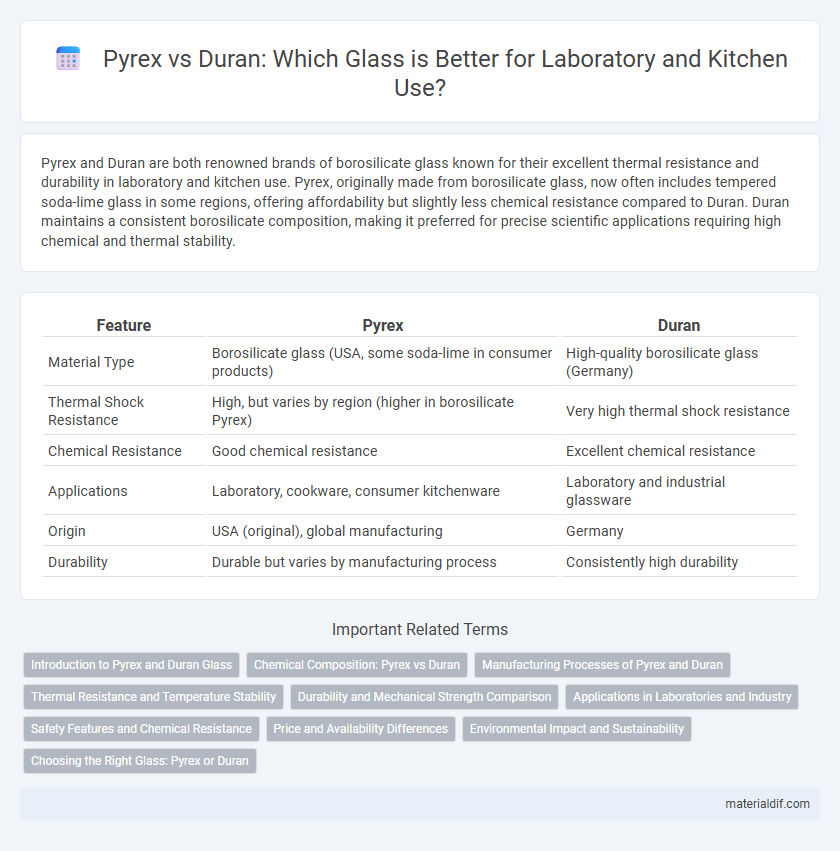Pyrex and Duran are both renowned brands of borosilicate glass known for their excellent thermal resistance and durability in laboratory and kitchen use. Pyrex, originally made from borosilicate glass, now often includes tempered soda-lime glass in some regions, offering affordability but slightly less chemical resistance compared to Duran. Duran maintains a consistent borosilicate composition, making it preferred for precise scientific applications requiring high chemical and thermal stability.
Table of Comparison
| Feature | Pyrex | Duran |
|---|---|---|
| Material Type | Borosilicate glass (USA, some soda-lime in consumer products) | High-quality borosilicate glass (Germany) |
| Thermal Shock Resistance | High, but varies by region (higher in borosilicate Pyrex) | Very high thermal shock resistance |
| Chemical Resistance | Good chemical resistance | Excellent chemical resistance |
| Applications | Laboratory, cookware, consumer kitchenware | Laboratory and industrial glassware |
| Origin | USA (original), global manufacturing | Germany |
| Durability | Durable but varies by manufacturing process | Consistently high durability |
Introduction to Pyrex and Duran Glass
Pyrex glass is a brand of borosilicate glass known for its high thermal resistance and durability, commonly used in kitchenware and laboratory glassware. Duran glass, similarly made from borosilicate, offers exceptional chemical resistance and mechanical strength, making it ideal for scientific instruments and pharmaceutical applications. Both Pyrex and Duran are trusted for their ability to withstand rapid temperature changes without compromising clarity or structural integrity.
Chemical Composition: Pyrex vs Duran
Pyrex glass typically consists of borosilicate with about 80% silica, 13% boric oxide, and traces of sodium and aluminum oxides, offering excellent thermal shock resistance. Duran glass also uses borosilicate composition but often has a slightly higher silica content, around 82%, which enhances chemical durability and resistance to corrosion. Both glasses provide superior chemical stability compared to soda-lime glass, making them ideal for laboratory and kitchen applications.
Manufacturing Processes of Pyrex and Duran
Pyrex is primarily manufactured using borosilicate glass, known for its high thermal resistance and durability, produced through a refining and forming process that ensures low expansion properties. Duran glass, also a borosilicate type, undergoes a similar melting and annealing process but features enhanced chemical resistance and clarity, achieved through precise control of raw materials and heat treatment. Both Pyrex and Duran employ advanced manufacturing techniques such as controlled atmosphere melting and automated forming to maintain consistent quality and performance for laboratory and kitchen applications.
Thermal Resistance and Temperature Stability
Pyrex glass, made primarily from borosilicate, offers excellent thermal resistance withstanding temperatures up to 450degC, making it ideal for everyday laboratory use and baking applications. Duran glass, also borosilicate but with a refined composition, provides superior temperature stability and thermal shock resistance, maintaining structural integrity under rapid temperature changes up to 500degC. Both glasses excel in chemical durability, but Duran's enhanced thermal properties make it preferable for high-precision scientific experiments requiring extreme temperature control.
Durability and Mechanical Strength Comparison
Duran glass offers superior durability and mechanical strength compared to Pyrex, with greater resistance to thermal shock and mechanical impact due to its borosilicate composition. Pyrex glass, while also borosilicate-based, typically contains a slightly different formulation that provides good, but comparatively lower, resistance to mechanical stress. In laboratory settings requiring rigorous durability, Duran is preferred for its enhanced performance in preventing cracks and breakage under extreme conditions.
Applications in Laboratories and Industry
Pyrex glass, made from borosilicate, is widely preferred in laboratories for its thermal shock resistance and chemical durability, making it ideal for heating, mixing, and storing chemicals. Duran glass offers excellent chemical resistance and mechanical strength, often used in industrial settings for reactors, fermenters, and precision laboratory apparatus requiring high purity and sterilization. Both types support rigorous scientific applications, but Duran's enhanced clarity and durability give it an edge in automated and pharmaceutical industries.
Safety Features and Chemical Resistance
Pyrex glass offers strong thermal shock resistance and is commonly used for kitchenware, but it is made from borosilicate glass with slight variations affecting durability. Duran glass, a premium borosilicate glass, provides superior chemical resistance and enhanced resistance to thermal shock, making it ideal for laboratory environments requiring stringent safety standards. Both glasses resist most chemicals, but Duran's higher purity and manufacturing precision ensure better performance in aggressive chemical conditions.
Price and Availability Differences
Pyrex glassware is generally more affordable and widely available in retail stores and online platforms compared to Duran, which is priced higher due to its superior thermal resistance and chemical durability. Pyrex is commonly used for household baking and storage, making it a popular choice among consumers seeking budget-friendly options. Duran glass, often preferred in laboratory settings, is less abundant in general retail but can be sourced from specialty scientific suppliers at a premium cost.
Environmental Impact and Sustainability
Pyrex glass is primarily made from borosilicate glass, known for its durability and resistance to thermal shock, but its production involves higher energy consumption and generates more carbon emissions compared to Duran glass. Duran glass, also borosilicate, is manufactured using more sustainable processes with lower environmental impact, including reduced raw material waste and enhanced recyclability. Choosing Duran over Pyrex supports environmental sustainability goals by minimizing carbon footprint and promoting circular economy practices in glass production.
Choosing the Right Glass: Pyrex or Duran
Pyrex glass is known for its borosilicate composition, offering exceptional thermal shock resistance and durability, making it ideal for laboratory and kitchen use where temperature changes are frequent. Duran glass, also borosilicate, provides high chemical resistance and clarity, preferred in scientific applications requiring precise visual observation and chemical compatibility. Selecting between Pyrex and Duran depends on the specific requirements for thermal resilience, chemical exposure, and clarity in your glassware use.
Pyrex vs Duran Infographic

 materialdif.com
materialdif.com